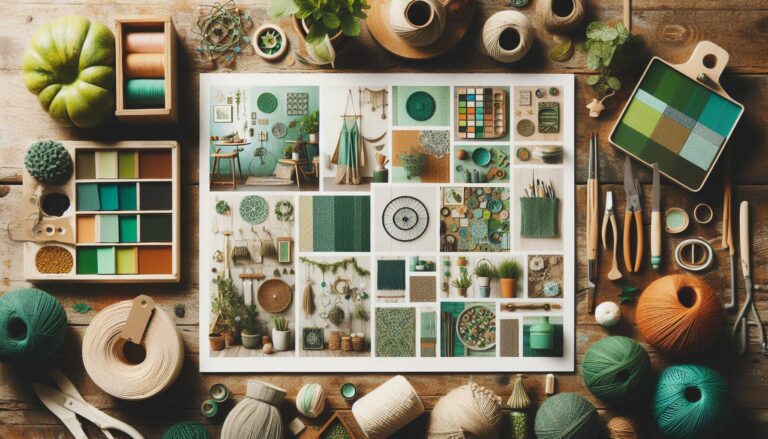6 Inspiring Eco-Friendly DIY Projects for a Greener Lifestyle

Introduction
Imagine walking into a home that radiates creativity, sustainability, and personal touch—each item is meticulously crafted to reflect a commitment to a greener planet. Now, consider how that vision could become a reality through eco-friendly DIY projects. The idea of adopting a green lifestyle often feels overwhelming, especially when faced with a myriad of choices and potential challenges. However, integrating DIY projects into your daily routine is a practical step and an exciting and rewarding way to contribute positively to the environment.
This guide will take you through an extensive array of DIY projects to enhance your eco-friendly lifestyle. Each project is explored in detail, from transforming old furniture and building a compost bin to making natural cleaners and creating reusable wraps. You’ll learn about the benefits, challenges, and trade-offs associated with each project, along with practical tips to help you get started. By the end of this article, you’ll have a comprehensive understanding of how to implement these projects effectively and the significant impact they can have on both your home and the planet.

Upcycling Old Furniture
What Is Upcycling?
Upcycling is the creative process of repurposing old or discarded items into something new and useful. Unlike recycling, which breaks down materials to create new products, upcycling involves transforming items while preserving their original form.
Why Upcycle?
- Reduces Waste: Upcycling prevents items from ending up in landfills, reducing waste and pollution.
- Saves Money: Repurposing old furniture can be significantly cheaper than buying new items.
- Adds Personal Touch: Upcycled furniture can be customized to match your style, making it unique and personal.
How to Upcycle Furniture
- Preparation: Start by cleaning the furniture thoroughly to remove dust and grease. If the item has old paint or varnish, strip it off using a paint stripper or sandpaper.
- Sanding: Sand the surface to create a smooth base for painting or staining. Sanding also helps remove any remaining old finishes.
- Painting or Staining: Choose eco-friendly, low-VOC (volatile organic compounds) paint or stains. Low-VOC products are better for indoor air quality and the environment.
- Finishing Touches: Replace old hardware with new knobs or handles made from sustainable materials, such as bamboo or recycled metal.
Example Project: Upcycled Chair
Original Condition: A wooden chair with chipped paint and a worn-out seat.
Transformation Steps:
- Preparation: Clean the chair and strip off old paint.
- Sanding: Sand the chair to remove imperfections and create a smooth surface.
- Painting: Apply a coat of low-VOC paint in a chosen color.
- Reupholstering: Replace the old seat cushion with one made from recycled fabric.
Challenges
- Time and Effort: Upcycling furniture can be time-consuming and may require some skill.
- Structural Issues: Older furniture might have structural issues that need to be addressed before upcycling.
Table 1: Upcycling Costs vs. Buying New
| Item | Upcycling Cost | Buying New Cost |
|---|---|---|
| Wooden Chair | $30 (paint, materials) | $150 (new chair) |
| Coffee Table | $50 (paint, hardware) | $200 (new table) |
Creating Your Compost Bin
What Is Composting?
Composting is a natural process of recycling organic waste into nutrient-rich soil. It involves decomposing organic materials such as kitchen scraps and yard waste into compost, which can enrich garden soil.
Why Compost?
- Reduces Waste: Composting keeps organic waste out of landfills, reducing methane emissions, a potent greenhouse gas.
- Improves Soil: Compost adds essential nutrients to the soil, enhancing plant growth and reducing the need for chemical fertilizers.
- Conserve Resources: Composting reduces the demand for chemical fertilizers and improves the health of your garden.
How to Build a Compost Bin
- Choose a Container: Select a large, durable container such as a plastic barrel or build a bin using wooden pallets. Ensure the container has good ventilation.
- Add Ventilation: Drill holes in the container to allow air to circulate, which speeds up the decomposition process.
- Start Composting: Add a mix of kitchen scraps (fruit peels, vegetable scraps, coffee grounds) and yard waste (leaves, grass clippings) to the bin.
- Turn Regularly: Stir the compost every few weeks to promote aeration and ensure even decomposition.
Example Project: DIY Compost Bin
Materials Needed: Plastic container, drill, compostable kitchen scraps.
Steps:
- Drilling: Drill holes into the sides and bottom of the container for air circulation.
- Filling: Add a mix of green (nitrogen-rich) and brown (carbon-rich) materials.
- Turning: Use a pitchfork or similar tool to turn the compost regularly.
Challenges
- Odor Management: Composting can produce odors if not managed properly. Ensure a good balance of materials to minimize smells.
- Balancing Materials: Maintaining the correct ratio of green and brown materials is crucial for effective composting.
Chart 1: Composting Materials
| Material | Type | Example |
|---|---|---|
| Green | Nitrogen-Rich | Fruit peels, coffee grounds |
| Brown | Carbon-Rich | Dry leaves, cardboard |
Making Homemade Natural Cleaners
Why Use Natural Cleaners?
Natural cleaners are made from everyday ingredients that are safer for the environment and your health. They avoid harsh chemicals found in many commercial cleaning products.
How to Make Natural Cleaners
- Basic Ingredients: Use common household items like baking soda, vinegar, and essential oils.
- Mix and Store: Combine these ingredients in spray bottles or jars for various cleaning purposes.
- Examples:
- All-Purpose Cleaner: Mix 1 cup of vinegar, 1 cup of water, and 10 drops of essential oil (lemon or lavender).
- Deodorizing Carpet Powder: Mix 1 cup of baking soda with a few drops of essential oil. Sprinkle on carpets, let sit, and then vacuum.
Example Recipe: Lemon-Vinegar Cleaner
Ingredients:
- 1 cup white vinegar
- 1 cup water
- Juice of 1 lemon
Steps:
- Combine ingredients in a spray bottle.
- Shake well and use to clean surfaces like kitchen counters and sinks.
Challenges
- Effectiveness: Natural cleaners may not be as strong as commercial ones and require more effort for tough stains.
- Shelf Life: Homemade cleaners don’t last as long as store-bought ones, so make them in smaller batches and use them within a few months.
Table 2: Comparison of Cleaners
| Cleaner Type | Ingredients | Pros | Cons |
|---|---|---|---|
| Commercial Cleaner | Synthetic chemicals | Strong and effective | Harmful to health and environment |
| Natural Cleaner | Vinegar, baking soda, essential oils | Eco-friendly, safe for health | Less powerful, shorter shelf life |
Building a Rainwater Collection System
What Is Rainwater Collection?
Rainwater collection involves capturing and storing rainwater in non-potable applications such as watering plants or flushing toilets. It’s a sustainable practice that conserves water resources.
Why Collect Rainwater?
- Conserve Water: Reduces reliance on municipal water supplies and helps conserve natural resources.
- Saves Money: Lowers water bills using collected rainwater for gardening or other non-potable purposes.
- Sustainable: Utilizes a natural resource and reduces the environmental impact of water usage.
How to Build a Rainwater Collection System
- Select a Barrel: Choose a large, food-grade barrel or container for rainwater collection.
- Setup: Place the barrel under a downspout from your roof to capture rainwater.
- Install a Spigot: Add a spigot near the bottom of the barrel to make it easy to access the water.
- Cover and Filter: Ensure the barrel has a lid to keep out debris and mosquitoes. Install a screen or filter to prevent large debris from entering the barrel.
Example Project: DIY Rain Barrel
Materials Needed: Barrel, downspout diverter, spigot.
Steps:
- Attach Diverter: Install the diverter to direct rainwater into the barrel.
- Install Spigot: Attach the spigot at the bottom of the barrel for easy access.
- Cover: Place a cover on the barrel to keep out debris and insects.
Challenges
- Maintenance: Regular cleaning of the rain barrel is necessary to prevent algae growth and ensure clean water.
- Contamination: Proper filtration is essential to prevent contaminants from affecting the collected water.
Chart 2: Rainwater Collection System Components
| Component | Purpose | Importance |
|---|---|---|
| Barrel | Stores collected rainwater | Essential for collection |
| Diverter | Directs rainwater into the barrel | Prevents overflow |
| Spigot | Allows access to water | Facilitates water use |
| Cover | Keeps out debris and insects | Maintains water quality |
Read More From Blog
Creating Reusable Food Wraps
What Are Reusable Food Wraps?
Reusable food wraps are an eco-friendly alternative to single-use plastic wraps. They are often made from cloth and coated with beeswax or other sustainable materials.
Why Use Reusable Food Wraps?
- Reduces Plastic Waste: Helps cut down on single-use plastics that contribute to environmental pollution.
- Cost-Effective: Can be used multiple times, saving money compared to disposable wraps.
- Eco-Friendly Materials: Made from sustainable materials like organic cotton and beeswax.
How to Make Reusable Food Wraps
- Materials: Use fabric scraps (organic cotton works well) and beeswax.
- Preparation: Cut fabric into desired sizes.
- Application: Melt beeswax and brush it onto the fabric. Allow to cool and harden.
- Use: Wrap food items or cover bowls, then wash and reuse as needed.
Example Project: DIY Beeswax Wraps
Materials Needed: Organic cotton fabric, beeswax pellets, parchment paper, iron.
Steps:
- Cut Fabric: Cut fabric into various sizes for different uses.
- Melt Beeswax: Place fabric between parchment paper and sprinkle with beeswax pellets.
- Iron: Iron over the parchment paper to melt and evenly distribute the beeswax.
- Cool: Let wraps cool and harden before use.
Challenges
- Durability: Beeswax wraps may need to be replaced after extensive use. They can lose their stickiness over time.
- Cleaning: Hand wash with mild soap and cold water to preserve the wax coating. Avoid hot water or machine washing.
Table 3: Reusable Food Wraps vs. Plastic Wrap
| Wrap Type | Benefits | Drawbacks |
|---|---|---|
| Reusable Wraps | Eco-friendly, cost-effective | Limited lifespan, requires care |
| Plastic Wrap | Convenient, disposable | Contributes to plastic waste |
Making Homemade Eco-Friendly Personal Care Products
Why Opt for Homemade Personal Care Products?
Homemade personal care products are made from natural ingredients and avoid synthetic chemicals, making them better for both your health and the environment.
Examples of Homemade Personal Care Products
- Face Scrub: Mix equal parts of sugar and coconut oil. Add a few drops of essential oil for fragrance.
- Body Lotion: Combine shea butter, coconut oil, and a few drops of essential oil. Melt together and cool in a container.
- Toothpaste: Mix baking soda, coconut oil, and a few drops of peppermint essential oil for a natural toothpaste.
Example Recipe: DIY Body Lotion
Ingredients:
- 1/2 cup shea butter
- 1/2 cup coconut oil
- 10 drops essential oil (lavender or peppermint)
Steps:
- Melt Ingredients: Heat shea butter and coconut oil together until melted.
- Add Essential Oil: Stir in the essential oil.
- Cool: Allow to cool and solidify before using.
Challenges
- Shelf Life: Homemade products may have a shorter shelf life compared to store-bought ones due to the lack of preservatives.
- Consistency: Achieving the right texture and effectiveness may require some experimentation.
Chart 3: Personal Care Product Ingredients
| Product | Ingredients | Purpose |
|---|---|---|
| Face Scrub | Sugar, coconut oil, essential oil | Exfoliation and moisturizing |
| Body Lotion | Shea butter, coconut oil, essential oil | Moisturizing and soothing |
| Toothpaste | Baking soda, coconut oil, peppermint oil | Cleaning and freshening breath |
Conclusion
Incorporating eco-friendly DIY projects into your life is not only an enjoyable way to engage with sustainable practices but also a meaningful approach to making a difference. Whether you’re upcycling old furniture, creating compost, making natural cleaners, collecting rainwater, or crafting reusable food wraps, every project contributes to a greener lifestyle.
The journey towards a more eco-friendly lifestyle starts with small, manageable steps. By embracing these DIY projects, you’re not only reducing your environmental footprint but also adding a personal touch to your home. Remember, each effort counts and collectively contributes to a more sustainable future.
So, grab your tools and materials, and dive into a project that resonates with you. You’ll find that making eco-friendly choices can be both fulfilling and impactful. Happy crafting!












